Este sitio web utiliza cookies para que podamos ofrecerle la mejor experiencia de usuario posible. La información sobre cookies se almacena en su navegador y realiza funciones como reconocerle cuando vuelve a nuestro sitio web y ayudar a nuestro equipo a comprender qué secciones del sitio web le resultan más interesantes y útiles.
Jesuits, Ships and GPS
We all know how to navigate. We type our address of destination into Google maps, and then the GPS device tells us, turn right in 500 meters, or turn left in 500 meters. But believe it or not, Christopher Columbus did not have Google maps. Navigators could usually tell how far north or south they were—their latitude—but for centuries had no good way to figure out how far east or west they were, their longitude. Anyone who has been in a boat and no longer able to see the shore can imagine how frightening it would be just to float along with no radio, no way of communicating, and no way of knowing just where you were.
Terrible tragedies happened. Once a fleet of British ships were on their home after a long, long voyage, and as they got close to Britain, they must have become relaxed. But it became stormy, and suddenly they couldn’t see where they were going, and because they didn’t know their longitude, they ran aground in the English Channel, and more than a thousand sailors, who thought they would be seeing their families in hours, all drowned.[pullquote align=»right»]Many Jesuits were lost at sea, but these brave men kept going, east to Asia and west to South America and south to Africa.[/pullquote]
Many Jesuits were also lost at sea, as you know. Sometimes because their tiny ships—made of wood and no bigger than a train car—broke to pieces in terrible storms; in some years, as many as a quarter of the ships leaving Portugal or Spain never reached their destination; sometimes they were attacked: in 1570 a pirate ship intercepted a boatload of Jesuits going to Brazil; they slaughtered 40 of the Jesuits, some they beheaded; some they simply threw into the water.
But sometimes it was simply because of the inability to navigate that Jesuits lost their lives. In 1555, three Jesuits were shipwrecked on a desert island on their way to the Far East, and eventually starved there. But, no matter the danger, these brave men kept going, east to Asia and west to South America and south to Africa. We know some of them very well: Frs. Xavier, Claver, Ricci, Anchieta.
[pullquote align=»left»]These men who never made it in some way are inviting us, each in his or her own way, to carry on the task that they could not complete.[/pullquote] But many of them we do not know, because they died before their ships reached their destinations in the New World. If we judge their result in a worldly way, they failed. But they had risked their lives to start the ministries and parishes that eventually became the schools that so many of us attended, and if their sacrifice do not bear fruit in their lifetimes, surely it was ultimately worthwhile. We can be grateful for their generosity and heroism and bravery. And maybe we can also imagine that these men who never made it in some way are inviting us, each in his or her own way, to carry on the task that they could not complete, by doing our own good works, in our families, schools, churches, and communities.
But let me return to my story about navigation, because it might help stretch the boundaries of our creativity as we try to imagine what our Jesuit network might be capable of becoming. Scientists long tried, with no success, to solve the problem of measuring longitude, in order to reduce the numbers of deaths at sea. Galileo had the idea that sailors could determine their longitude by taking observations of the eclipses of the various moons around Jupiter. Galileo was smart, but incredibly impractical: how in the world was some sailor with a 17th century telescope going to stand on a rocking ship and even see Jupiter, much less make accurate calculations about its moons?[pullquote align=»right»]If we judge their result in a worldly way, they failed. But they had risked their lives to start the ministries and parishes that eventually became our schools.[/pullquote]
Then, a few years after Galileo, a Jesuit had a better idea for solving the problem. Athanasius Kircher,a German Jesuit who taught in Rome in the mid 1600s, has been called, “the last man who knew everything” because he was an expert in languages and mathematics and sciences. And he knew that as you get further east or west of the north pole, the needle of a compass points a tiny bit away from true north. And Kircher also knew that Jesuit missionaries were working all over the world known to Europeans at the time—in fact no human organization had a network of people in so many places, and he thought if he could get each of these Jesuits to measure how far their needles were from true north in each of their specific locations, he could prepare a very simple chart, and any sailor could tell his longitude by checking his own compass needle and comparing it to Fr. Kircher’s proposed chart. Think how many lives might have been saved thanks to the ingenuity, collaboration, intelligence, and hard work of the Jesuit network. [pullquote align=»right»]They tried to do something that only Jesuits could have accomplished at that time in human history.[/pullquote]
So he wrote to Jesuits all over the world, and they started writing back with their readings. But in the end, they couldn’t quite succeed, because 17th century compasses were too primitive for the accurate readings that would have been needed. But they almost succeeded. They tried to do something that only Jesuits could have accomplished at that time in human history.
This post is an excerpt of a Chris Lowney’s talk at World Union Jesuit Alumnae Meeting in Medellin (Colombia) on 16th August 2013. The whole conference may be found on this website [English] [Spanish]. Photo from Flickr by brize.





